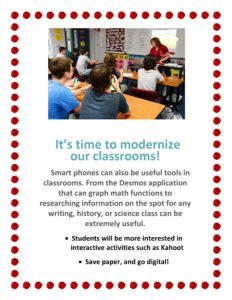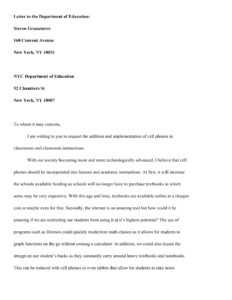
Rationale
After completing the inquiry based research paper, I believed that a flyer would be an appropriate genre to convey a message that I want. A flyer is a quick and easy way to convey a message to the observer using a picture and a small amount of words. At first I was stuck between a flyer and a brochure, but realistically a brochure has to be physically obtained whereas a flyer can be hung anywhere and doesn’t require the audience to have a tangible copy of it. Furthermore, teachers are more inclined to read a flyer as compared to opening up a brochure and reading a lot of text.
My flyer is directed mainly to teachers in high schools and professors in universities. The message that I am trying to convey is for these teachers and professors to incorporate cell phones in their lessons and classrooms. By listing a few benefits of doing so, hopefully the viewer’s attitude of cell phones in classrooms will change.
In a way, it is also directed to students where they would also stumble upon this flyer and would also be interested in incorporating their portable technology in classrooms. Using a little bit of speculation, maybe, some students can start a petition for this.
The purpose of this flyer is to perhaps persuade or even experiment using cell phones in classrooms. In the flyer, I have listed a few benefits of doing so. An example includes saving paper by having online interactive assignments such as Kahoot. The end goal of this flyer is to have teachers at least experiment including cell phones in their instructional lessons.
Reflection
A flyer was an appropriate genre to use to quickly convey a message in an educational setting. At first, it was hard for me to think of a way to grab a teacher’s attention and perhaps persuade them to change their methods of teaching. With a simple flyer, the facts are right in front of their faces. They could save a good amount of paper just by making their classrooms interactive by allowing assignments and quizzes to be online. That is something that is listed on the flyer and could also spark interest among students.
By using a picture of a classroom in which paper is barely present and the teacher is doing an assignment on Kahoot, this could give students and teachers an idea of what their classroom could potentially look like where more students are engaged in the lesson.
The rhetorical situation made in this is that it is finally time to modernize classrooms and incorporate the abilities cell phones have instead of being outdated with textbooks and old methods of teaching.


Rationale
For my second choice of genre, I wrote a letter that is directed to the New York City Department of Education and its purpose is to unban cell phones in high schools and incorporate them into classrooms. A letter is also an appropriate genre as it is ultimately up to the Department of Education on how to address this matter. It isn’t really up to the teachers or the schools as the Department is in charge of all of them. The Department is more likely to respond to a letter than hear a speech about this matter.
The purpose of this letter is to persuade the Department of Education to allow for cell phones to be used in lesson plans and instructions. At this time, there is a soft ban on cell phones where they are allowed to be brought into schools, but aren’t allowed to be used. This letter touches on some valid points as to why cell phones should be allowed such as not having students carrying textbooks. This could save a lot of money as textbooks don’t need to be bought anymore and that funding can be used elsewhere. This in turn means that the Department can save a good amount of money.
Reflection
This letter was made with a little bit of bias involved as it is naturally coming from my head. The audience is clearly the Department of Education and the stance is evident that cell phones should be incorporated in classroom activities.
The rhetorical situation is that the methods of teaching is very old and outdated and perhaps it is time that we modernize our schools. This can be done by modernizing our lessons and by allowing our cell phones to be a strong tool for education. Instead of not allowing us to use our cell phones, why not teach us how to actually use one effectively? That is something that is mentioned in the letter and perhaps will alter the department’s opinion.


